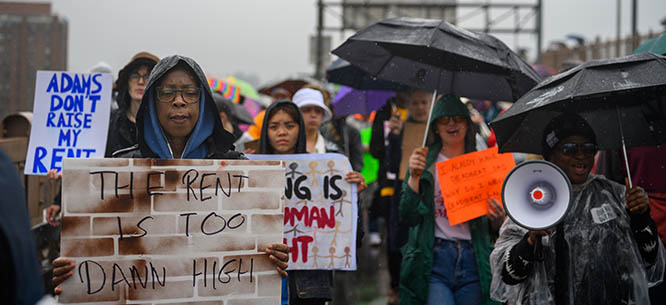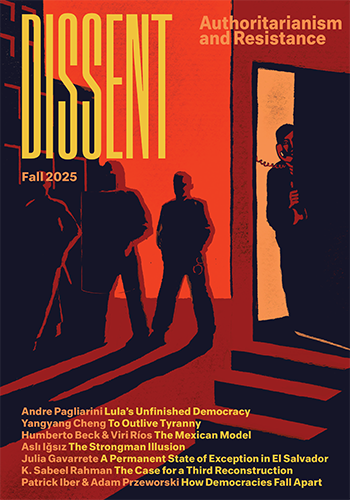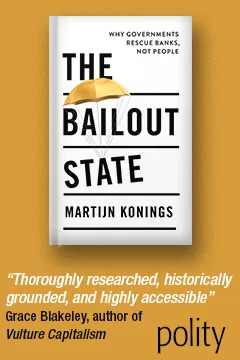Tenants on the March: An Interview With Cea Weaver
Tenants on the March: An Interview With Cea Weaver
“Organizing tenants has the potential to shape the political landscape for decades to come.”

In many parts of the country, rising rents have hit a political limit, as politicians, unions, and community organizations increasingly recognize the centrality of housing to the cost-of-living crisis. New York State’s 2019 Housing Stability and Tenant Protection Act, San Francisco’s 2022 collective bargaining ordinance for tenants, and Los Angeles’s 2022 “mansion tax” represent new forces in local politics—and alternative bases for the struggle over power within our society. These initiatives use the state to reshape the business models and ownership patterns pushing workers and their families further away from their jobs, into smaller, more expensive living situations.
To learn more about the tenant organizing that’s been happening in New York, I spoke with Cea Weaver, director of Housing Justice for All, the coalition that won the 2019 rent law. We spoke before November 5, but the election results have only made conversations about how tenants have organized themselves all the more urgent. An analysis from Cornell University shows that when candidates support tenant protections, the owner-renter voter turnout gap gets cut in half. Strong tenant protections also boost renter turnout: according to Princeton University’s Eviction Lab, a 1 percent reduction in residential evictions increases voter turnout by nearly 3 percent.
In city after city, voters described the rental housing crisis as front of mind when heading to the polls. But after a lukewarm nod to rent caps early in her campaign, Kamala Harris abandoned the policy. The collapse of turnout in Philadelphia, Detroit, and Milwaukee below Biden’s levels in 2020 made up the margin of defeat for the Harris campaign in Pennsylvania, Michigan, and Wisconsin.
The struggle over housing regulation and production is, however, more than a plank in campaign platforms: it is also key to the question of how to create and shape economic growth. Investors are banking on federal and state permitting reform laws to unleash a private building boom, accelerate growth, and ease pressure on the economically beleaguered commercial real estate industry. Absent greater public financing, landlord regulation, and alternative ownership models, such growth will create a kind of city little different from the present—in which quality housing requires an ever greater share of workers’ paychecks. Such visions of urban renewal centered on yuppies and YIMBYs are not going to save our cities.
The answer to the housing problem is, therefore, central to a broader vision of what the relative powers, privileges, and responsibilities of business and elected government in the U.S. mixed economy should be. Who can step in to offer a new direction for urban politics? Tenants are one answer.
—Andrew Elrod
Andrew Elrod: To begin with a simple question, what are the conditions of rental housing in the United States today?
Cea Weaver: There is a profound affordability crisis in rental housing. In almost every single state, there is a huge shortage of housing that is affordable to low-income and working-class households, and more of the population is renting in almost every major city. Rental housing is often poorly maintained, and the law offers renters limited stability. Almost all housing policy prioritizes property owners over renters; it treats housing as an investment vehicle. In New York, where I organize, nearly half the state is renting, and more than 50 percent of renters cannot afford their monthly housing costs; many of these families don’t have the basic right to renew their lease. This means that a simple call to code enforcement often leads to retaliation and an eviction notice. More people are living in this insecure housing system with home ownership out of reach.
Elrod: Journalists, lobbyists, and politicians currently engage with this issue in terms of a shortage of housing in general, which leads to scrutiny of the barriers to new construction projects. What does it mean to see this as a shortage of affordable housing in particular?
Weaver: There’s been a tremendous amount of ink spilled about the need to do things like reduce zoning restrictions to produce more housing, which is supposed to lead to lower rents for everyone. The truth is that measures designed to spur the production of housing generally don’t reduce rents on their own. First, housing is a pretty inelastic market; it takes a long time to build a building. Demand is growing far faster than the market can produce housing, which means that even when new housing is produced, rents are unlikely to adjust downward. Moreover, building new housing in a neighborhood can encourage other investors to come in and develop in that neighborhood, so that even if the overall supply of housing is increasing, real estate speculation is increasing as well. Finally, the real crisis of housing supply is for people who are low-income, no-income, or working-class. The massive shortage of affordable homes for these renters is the number one factor that is leading to skyrocketing homelessness in almost every state. And the market’s not going to build housing for people who are very low-income. It just can’t. That doesn’t mean that supply isn’t important. We need places for people to live. But it does mean that a supply-only approach to solving the housing crisis isn’t going to lead to the housing outcomes we need.
Elrod: This is related to a serious problem with slum housing in American cities. Should that be part of the discussion when we talk about the affordable housing crisis?
Weaver: Housing conditions are deeply important. The underlying problem is real estate speculation. Landlords use a lack of repairs to force people out of their homes so that they can empty the building and then raise rents. That cycle happens again and again. The unsafe living conditions are downstream from the building being treated as something that’s meant to generate wealth for a landlord and not something that’s meant to be a place for somebody to live.
Elrod: Let’s get into the structure of the market, which produces these downstream effects like unsafe living conditions and cyclical waves of neighborhood investment and disinvestment. The business model for managing multi-family residences depends on removing people who can’t pay higher rents from their units. In many places with more recent population growth, this displacement process is naturalized as a market transaction. But in older cities with a history of working-class organization, laws regulating rent increases remain on the books—in New York City, for example, about half of all apartments are stabilized, and in Los Angeles the share is two-thirds. Stabilization laws, which often allow rent increases between tenants but restrict them during a single tenancy, create a tremendous incentive for landlords to use a variety of tactics to empty out apartment buildings in working-class neighborhoods. What are the business practices that you’ve encountered in your time organizing?
Weaver: I started doing tenant organizing in New York City in 2010. At that time, there was a global foreclosure crisis that had been fueled by a massive expansion of private equity–backed mortgages in the residential market. Traditionally, a bank would lend somebody money to buy an apartment building, they would pay off the mortgage, and it was generally a safe and stable investment—like a 401(k). But in the real estate bubble that led to the 2008 financial crisis, new types of lenders were entering the market, expecting a much larger return on investment—20 percent or 30 percent. That’s untenable, especially in a market with rent stabilization.
In 2010, I was organizing in multi-family buildings that had gone into foreclosure. By the time a multi-family building reaches foreclosure, the landlord has probably tried to do everything possible to avoid it, including reducing maintenance costs by stopping repairs or harassing and evicting tenants so they can raise the rent.
The buildings I was organizing were, for that reason, extremely physically distressed and functionally abandoned by their owners. The bank was supposedly in charge of the building but was not making repairs. We saw this as an opportunity to form tenant unions and demand the city take over distressed rental housing and convert it to social housing.
Unfortunately, this didn’t work—and the real reason is rent stabilization laws that incentivize pushing somebody out and bringing somebody in who’s going to pay a higher rent. This meant that as the market recovered, the banks were able to flip properties to new private equity landlords who would get massive rent bonuses in exchange for evictions. Where I live in Crown Heights, Brooklyn, we saw this cycle where landlords and bankers and policymakers had driven up the value of real estate using speculative financial capital, the housing market crashed, and then the solution to that was just a different private equity firm coming in and owning the buildings. This cycle fueled waves of gentrification in Crown Heights. As tenants, we experienced how loopholes in rent stabilization and poor enforcement of tenants’ rights were driving a crisis of displacement and rising rents in the neighborhood overall. That’s when we formed the Crown Heights Tenant Union (CHTU) and began organizing for rent stabilization at a broader level.
Elrod: In Los Angeles, one phrase we hear on the business end is “re-tenanting.” There’s a market for this service among large, multi-family owners, and the people they hire often get paid by the unit and keep the difference. So they have an incentive to minimize what tenants get in a buyout, and will often use tactics of harassment to get them to accept a lower rate. In New York, how do landlords remove housing from stabilization?
Weaver: New York has had some form of rent control since the 1920s. The version that we have today is the 1974 Emergency Tenant Protection Act, and buildings with six or more units built before that year are subject to rent stabilization. From 1974 until 2019, when the state of New York passed the Housing Stability and Tenant Protection Act (HSTPA), apartments were rent stabilized until they reached a “high rent threshold,” which was roughly $2,700 a month in 2019. So that’s the goal for the owner: you’re trying to reach that threshold and then you’re trying to get that person to leave. Landlords could raise rents on stabilized apartments in a number of ways: they would receive an automatic 20 percent increase in the rent every time the apartment was vacated, and they could make other “updates” to the units—often shoddy and fraudulent—in order to raise the rent even higher. Eventually they could bring the unit out of rent stabilization.
In 2019, we were able to eliminate most of these loopholes. Now landlords cannot raise monthly rents in between tenancies more than around $120, and apartments are deregulated only in rare circumstances, like demolition.
Elrod: What business calculation would lead a landlord to choose to keep units vacant?
Weaver: One thing they would do in the past is wait for the unit next to it or above it or below it to become vacant, and then combine them and bring them out of stabilization. This is a lot harder to achieve today. Sometimes landlords hold units vacant because they want to sell an empty building. Buildings are much more valuable vacant, because you can just rehab the whole thing at once. If rent-stabilized units are well below market, which they are in some neighborhoods like the Lower East Side, you are going to see an incentive to keep units vacant until you can do something else with the land. You also sometimes see empty rent-stabilized apartments for different reasons. There’s a building we’re working with right now that’s half-empty because the landlord died and his kids are fighting in court over who’s going to own it. You see a lot of people who end up sitting on something that’s very valuable and it turns into subpar housing, because there are really poor standards in the industry. I think that landlording should be much more professionalized than it is.
Elrod: In 2019, as you mentioned, the state of New York passed a very comprehensive reform of its rent-control laws, which was won by Housing Justice for All, where you work. Tell me a little about how the coalition came into being.
Weaver: From 2010 through 2015, I was organizing for tenant control over the rent-stabilized housing in Crown Heights, and these loopholes in the laws were making that task really difficult. We would get a landlord to the bargaining table, and the tenant union would demand things like a five-year rent freeze, leases for all the tenants, repairs, and so on. But then the building would get flipped to another speculator, and we’d be starting from scratch. We were trying to get ahead of that, which is why the CHTU got really involved in a failed campaign to strengthen and expand rent stabilization in 2015. That was a massive loss.
We were hindered by the fact that the real estate industry controlled the political agenda in Albany. They had the Independent Democratic Conference (IDC), a caucus of Democrats who sat on the Republican side of the aisle, from districts in the Bronx, Rockland County, Crown Heights, Upper Manhattan, Central Queens, right outside of Syracuse, and Staten Island. Some of these districts are purple, but many of them are super-majority renters and not purple at all. They’re true Democratic districts.
We met with a state senator in 2017 who wanted to run for statewide office. We told him he should run on strengthening and expanding rent control, and he said, “Tenants are a sleeping giant.” He was saying no to our question because the property owners were the ones who were involved, and tenants were asleep. But to us that also meant: “Tenants are a giant! We should do something about it.” We decided to form a statewide tenant organization—Housing Justice for All—and go on the offensive in 2019, not just to strengthen our existing stabilization laws but to expand them to cover the whole state; we wanted to bring rent stabilization to smaller buildings, and to try to reregulate units that we had lost. We didn’t win all of that. But we won a lot of it.
Elrod: Who makes up the coalition?
Weaver: There are three groups of people that made the coalition successful. We had the legacy rent-stabilized tenant organizing groups who were involved in rent-law campaigns between 1974 and 2019. We also worked with organizations like the New York Working Families Party because we thought it was important to politicize the issue. And then the third group is a newer, younger renters’ rights movement, in the form of the CHTU and organizations like it but also the Democratic Socialists of America. Upstate and downstate there were tenant organizations with newer activists who were politicized for the first time by Bernie, or in response to Trump. All these groups had different organizing traditions. Bringing them into the movement helped defeat the IDC in the 2018 Democratic Party primaries and set the tone for what the political agenda would look like in 2019.
Tenants are profoundly important political actors, and organizing tenants has the potential to shape the landscape for decades to come. We are in a moment when a real estate executive from New York City—one with a history of slum housing and racial discrimination—has ascended to the presidency once again. The fact that the Democratic Party ignored renters, and ignored the escalating cost of housing, is one of the reasons why. If the cost of housing keeps skyrocketing, more and more people will turn to the right. We are already seeing it, and we are going to continue to see it.
The story of the IDC, and how Housing Justice for All came together during the last Trump administration to get them out of office, is an important one for where we go next. It shows that Democrats lose when they go moderate and win when they run on issues like universal rent control that really promise to deliver for working-class voters.
Elrod: This agenda basically closed the vacancy loophole, removing the incentive for large rent increases driving some of the worst landlord behavior. How dramatically has that changed the nature of the business in the state?
Weaver: It’s a little hard to know. Because as soon as we passed this big law, there was a pandemic, which really defined the housing market for the next few years. But there was a recent report showing rent-stabilized buildings selling at 67 percent of their 2018 value. For the real-estate industry, this is being painted as a big crisis and a sign that the rent-stabilization reforms are not working. For tenants it’s the opposite. The market was fully out of whack; speculation was driving displacement all over the city. No one guaranteed the real estate industry that they were going to get massive returns on these investments in New York City. The prices are coming closer to reality.
Elrod: Management companies promised banks that they would be able to undertake a wave of displacement that the 2019 law seems to have prevented in some sense. Now they can’t pay back those loans because their gentrification business models are illegal.
Weaver: Along with the pandemic. People are leaving the city because they can’t pay rent, whether landlords like it or not.
Elrod: In Los Angeles, the pandemic was a huge opportunity for accelerating displacement, even as people left of their own accord. Some people with access to finance and unencumbered by ethical concerns about displacing thousands of people have succeeded in flipping large parts of Koreatown, East Hollywood, West Adams, Boyle Heights, and Highland Park. Living through the pandemic, you saw the process of buildings slowly falling apart through owner neglect, then undergoing a massive renovation or demolition, and then new residents moving in and really changing the demographics and class character of the neighborhood to benefit the new owners. So I’m fixated on the fact that you closed that loophole in New York. HSTPA did not include production, right?
Weaver: No. It’s primarily about reforms to rent stabilization and some other eviction protections.
Elrod: How do you think about the way production and regulation issues compete for priority in movement spaces? In Los Angeles, for example, the major victory on the housing front has been the passage of Measure ULA in 2022, which is a tax on the sale of real estate valued at $5 million or more. High-dollar real estate basically has to pay a sales tax, which will generate hundreds of millions of dollars each year. There’s been litigation to slow it down, but most of the politics until recently have been about how that money is spent—how much of it should go to strengthening existing regulatory authorities, inspection procedures, and enforcement, versus subsidies to developers to produce new housing. How have you experienced that divide?
Weaver: Most fights over production have to do with zoning regulations and incentives to produce any housing that includes below-market units. Anywhere in New York City that gets rezoned, the landlord is going to have to build a little bit of affordable housing. The whole assumption of inclusionary zoning is that landlords are still going to want to build, so land values need to be high enough to bring big returns on investment even if some housing is going to be affordable. So zoning programs typically rely on gentrification. They’re designed for a neighborhood like SoHo or the East Village, but they’re being misapplied in a neighborhood like East New York, which is incredibly distressed and poor.
The whole frame of zoning as the primary affordable housing policy doesn’t work. Zoning matters, but to reach 100 percent affordable housing, the government needs to fund it. That still relies on private developers who are motivated by profit, and whose primary goal is to raise the value of urban real estate—and they can use public money to do it. As a result, there is a whole industry in New York City of for-profit affordable housing providers that, in essence, rely on public-sector money to invest in neighborhoods and provide income-targeted housing, with the private sector capturing the profits. And when the city relies solely on these types of players to produce a critically important good—housing—the developers end up having far too much power at the table. The city is worried that if it starts to ask for too much below market or too many amenities, developers are going to say, “No, we can’t do it.” So the city controls the pocketbook, but the landlords control the price tag, and the landlords are the ones who ultimately profit.
The alternative is for the public sector to get a lot more involved in production. The state needs to be actively building housing and controlling the price of it—not just the housing that it builds, but also the market generally. In an ideal world, the government is regulating market costs for renters through things like rent stabilization and rent control, but also by intervening in the development market directly.
Elrod: Expand production in the low-rent part of the market and expand regulation of existing structures where owners want higher rents. Who’s out there leading with this alternative framing of the housing crisis?
Weaver: We have been working closely over the last few years with state-level elected officials like Assemblywoman Emily Gallagher and Senator Cordell Cleare, who have introduced bills in Albany to expand public-sector social housing production, and then at the federal level with Congresswoman Alexandria Ocasio-Cortez to introduce and campaign for new public-sector rental housing. Both the AOC Homes Act and Gallagher and Cleare’s Social Housing Development Authority (SHDA) in New York do two things. First, they encourage state-led production of mixed-income housing. We want to be able to serve the entire working class, whether you are currently homeless or you’re a teacher in our public school system who can’t afford to live in New York. Second, they allow the public sector to purchase existing rental housing. So you could form a tenant union, organize for better living conditions, demand that your landlord fix things, take them to court and sue them. Then the landlord could say, “I’m fed up with this building that is full of organized renters,” sell the housing to the SHDA, and you could become a tenant of the public-sector housing authority. The SHDA functions as a public-sector community land trust. You could form a cooperative with your neighbors, run it as shared-equity housing, but the SHDA would own the land underneath and serve as its steward.
Elrod: So, it would create a new public corporation, with access to independent financing but democratically controlled?
Weaver: In the Gallagher–Cleare bill, the SHDA is governed by a nineteen-person board that is a combination of political appointees and people who are elected out of the buildings. It’s important to remember that this requires ongoing organizing to build tenant unions. It’s the same thing that happens with rent boards for rent stabilization and control. Tenants and landlords go to debate with one another, but unless the tenants are organized, the landlords are going to run the table.
Elrod: The reason that there’s an opportunity for a new authority to govern the owners of distressed multi-family housing is that the existing regulatory procedures don’t seem to offer solutions, right? There are laws; American cities have not only building codes but habitability codes, which are enforced by city agencies. But it seems like there is political demand for some other kind of enforcement.
Weaver: If you are the City of New York, and you’re running the housing code department, and all of a sudden you start doing a very good job, the cost of supplying rental housing is going to go up for landlords. Because if fines are going to be enforced, they’re going to have to make repairs. And then the landlords are going to say, “You are doing too much. We’re going to leave the city.” If you believe it’s important to maintain a favorable environment for real estate investors, you can only go so far when it comes to rent control and code enforcement. We need the public sector to see that if the landlords aren’t doing it, we can do it ourselves. If the public sector believes that, then they will start doing code enforcement, because there’s an alternative, whether it’s through social housing, shared equity cooperatives, community land trusts, or public housing. The SHDA is about calling the bluff on the threat that landlords hold over the government’s head.
Andrew Elrod is a writer and historian who works in New York and Los Angeles.
Cea Weaver is the director of Housing Justice for All, a network of tenants’ organizations across New York State.






